
views
- Keep your Wandering Jew in a warm spot (around 50–80 °F (10–27 °C)) with lots of bright, indirect sunlight.
- Pot your plant in well-draining potting soil in a container with drainage holes. Keep the soil moist, but not soaking wet.
- Pinch or prune the leaves when the plant gets leggy to promote bushiness, or when any leaves or vines begin to brown or rot.
Potting Your Wandering Jew Plant
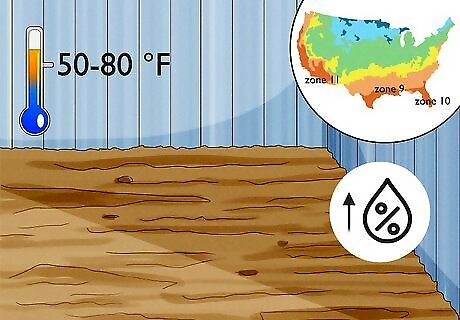
Choose a spot for your plant that's 50–80 °F (10–27 °C) year round. Wandering Jew plants (also called "wandering dudes" or "inch plants") are native to South and Central America and prefer lots of indirect sunlight, high humidity, and warm temperatures around 50–80 °F (10–27 °C). They grow well indoors, but if you plan to keep your plant outdoors, it may need to be brought in during colder months. Whether you keep your plant inside or out, make sure you put it somewhere where it'll get plenty of bright, indirect sunlight. Refer to this map to see if your area's temperatures are warm enough to support a Wandering Jew plant, if you're planning on keeping it outside. According to the USDA, the Wandering Jew plant grows best in zones 9-11. If you don’t live in USDA hardiness zones 9-11, keep in mind that you may not be able to keep your plant outside during the winter. You may want to grow it inside instead.
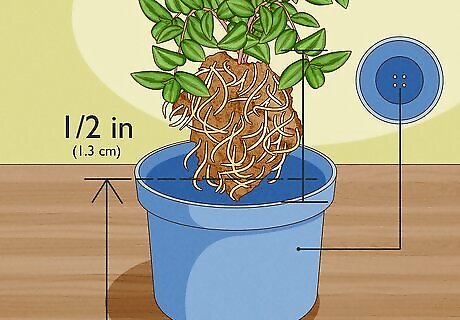
Choose a pot about ⁄2 in (1.3 cm) bigger than the root ball, with holes. Opt for a regular gardening pot with a saucer or a hanging basket. Regardless of what you choose, make sure the pot is about ⁄2 in (1.3 cm) bigger than the root ball and that there are holes for water drainage. Though Wandering Jews prefer moist soil, if the water doesn’t drain properly, it may result in root rot. If you use a hanging basket, remember to turn it daily so it gets equal amounts of sunlight. If you’re hanging your plant, choose a lightweight or plastic pot so it won’t fall. This also makes it easier to move inside in case of frost.
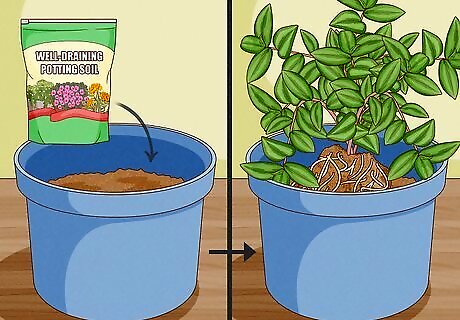
Pot your Wandering Jew plant. Fill the pot about two-thirds of the way with light, well-draining potting soil, then place the plant in the center of the pot. Add soil to surround and fill in the sides. Gently press down on the soil around your plant and water it until the soil is completely moistened. Be careful not to use soil that’s too heavy, as Wandering Jews need light soil that drains well. Buy well-draining soil, or, if you already have heavier soil, mix equal parts soil with compost, or equal parts soil, compost, and peat. Purchase a Wandering Jew plant at a gardening or home improvement center, or propagate cuttings from established plants. Wandering Jew cuttings grow very quickly.
Watering, Fertilizing & Pruning Your Plant
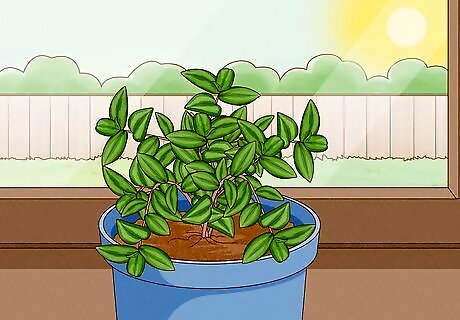
Keep your plant in a spot that gets bright but indirect or filtered sunlight. Wandering Jews are very hardy plants, but need the perfect amount of sun exposure to stay bushy and colorful: too much direct sun may cause their leaves to burn, but they also need a healthy dose of sunlight every day to maintain their vibrant color and their bushy appearance. If you can, keep them in a spot that gets bright but indirect or filtered sunlight. If you’re growing your plant indoors, an eastern facing windowsill is a good spot. The plant will receive bright indirect light throughout the day, but watch to make sure the space doesn't become too hot in the afternoon. If so, move the pot a few feet away or use a curtain to filter the light. If the plant primarily remains outside, find a spot that receives indirect sunlight. This could be on a porch that gets morning sun for several hours. Just make sure that it's not sitting in direct sunlight without any shade for most of the day.
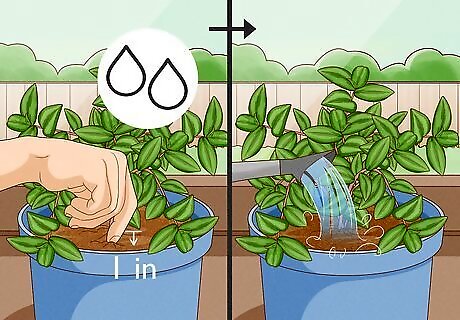
Keep the soil moist, but not too wet. Wandering Jews like the soil to be damp, but they don't want to drown! Every day, stick your finger inside the soil about ⁄2 in (1.3 cm) deep. If it feels dry, add enough water to completely moisten the soil. Be sure the excess water runs out of the bottom of your pot. Make sure not to water straight into the crown of the plant or it may rot. If you've set your pot on a saucer, empty the saucer when it fills. The plant's growth will slow in the winter months, meaning it needs to be watered less often. Simply let it remain a little dry for a bit longer before watering. Some people find it convenient to put self-watering aqua globes in their plant pots; however, these glass globes require cleaning and regular filling. You'll still need to monitor your plant's moisture if you choose to use them.
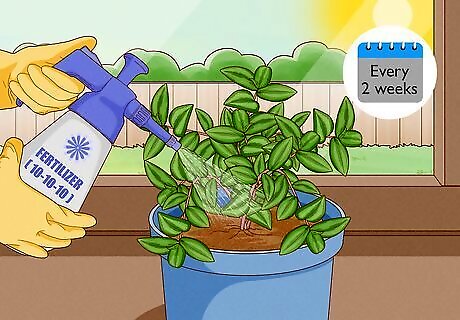
Fertilize your plant biweekly during the growing season (spring to early fall). Every two weeks, give your plant some liquid 10-10-10 fertilizer that has been diluted with an equal part of water. Liquid 10-10-10 fertilizer is considered to be an all-purpose fertilizer made up of ten percent nitrogen, ten percent phosphorus, and ten percent potassium. Read the container's instructions carefully before fertilizing, as some liquid fertilizers may actually be powders requiring you to mix in water.
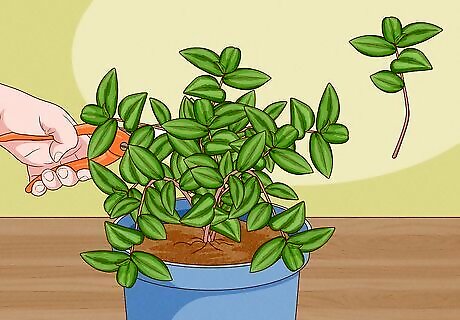
Prune your plant to promote growth when it gets leggy. As the plant matures, it's likely to develop some long, leggy vines. To encourage new growth, pinch back or use pruning shears to cut off any leggy stems. Be sure to cut the stems above a leaf node: each stem needs at least 2 leaves left over to regrow. Don't be afraid of cutting too much! You can prune back about a quarter of the plant. This will encourage the plant to fill in rather than continue to grow out through tendrils. The best time to prune is during the spring and summer months, when the plant is putting on the most growth. After you've pruned, give the plant a chance to put on new shoots and fill in. If you find your plant is too dense and bushy, you'll need to prune around the base so that the plant can get adequate circulation and sunlight.
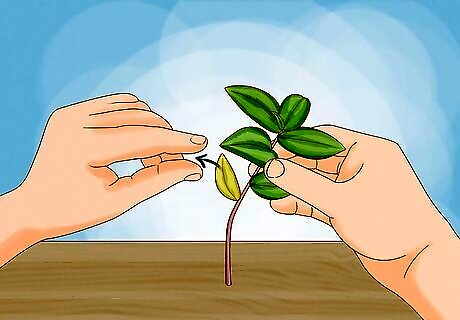
Pluck or cut off any diseased, rotted, and dead leaves. Eventually the plant will stop growing leaves at the base but will keep growing tendrils. Revive the plant by removing any diseased or dead leaves or by taking cuttings from your plant to propagate a new, healthy plant. Propagate cuttings in water, or simply set the cuttings on top of the soil.
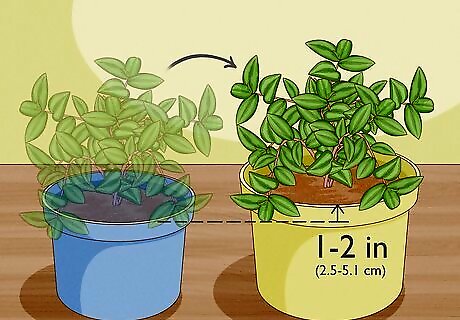
Repot your plant when it outgrows its container. Because Wandering Jews grow so quickly, even a healthy plant will likely need to be repotted every year or so. Delicately remove your Wandering Jew from its current container and repot it in a container 1–2 in (2.5–5.1 cm) larger than the current pot. Add fresh soil to the new pot. Generally, expect to repot your plant annually, but keep an eye out for signs your plant has outgrown its container within that time frame: once you see roots creeping out from under the plant through the drainage holes, or popping up through the soil, it’s time to repot.
Preventing Pests & Disease
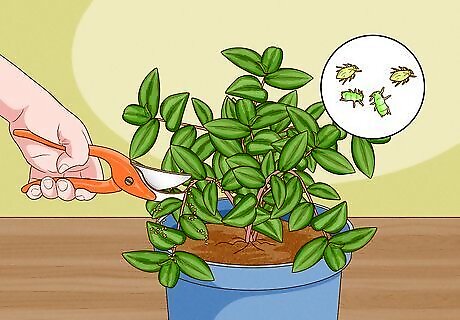
Remove stems with aphid infestations. New growth on Wandering Jew plants often attracts tiny green insects called aphids. They're usually found near stems. Get rid of aphids by pinching off or pruning the affected stems and heavily misting the remaining plant with water. Alternatively, use a hose or high-powered stream of water to blast them off of the leaves.
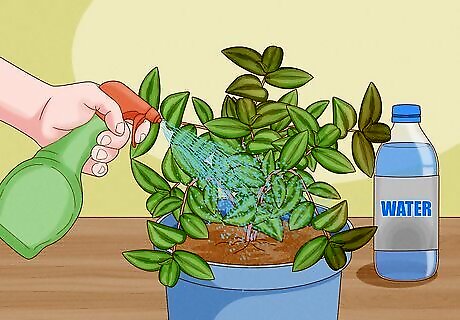
Refresh brown leaves by misting your plant with water. When the humidity is low, your plant's leaves will turn brown, but periodic water misting will help the leaves stay vibrant. Keeping the leaves wet will also help with any aphid problems your plant may develop. Fill a spray bottle with water and just mist until the leaves are lightly moistened. Try to use distilled or bottled water when misting the leaves for the best results. Brown leaves can also be a sign that your plant is getting too much sunlight. In this case, make sure your plant is not directly in the sun by moving the pot or placing a filter, such as a curtain, in between the plant and the window.
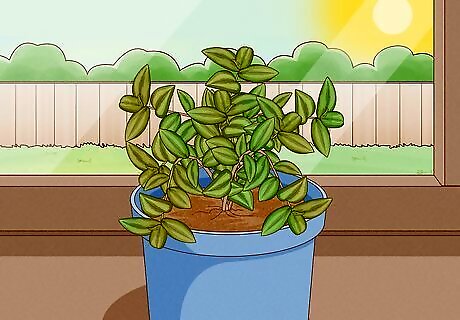
Restore faded leaves by giving your plant more sun. Leaves that lack their notable vibrancy and color are probably not getting enough sunlight. Gradually increase the amount of sun your plant receives so that you don't shock the plant. This might involve moving the pot closer to a window that receives more light or finding a sunnier spot in the yard for your plant.
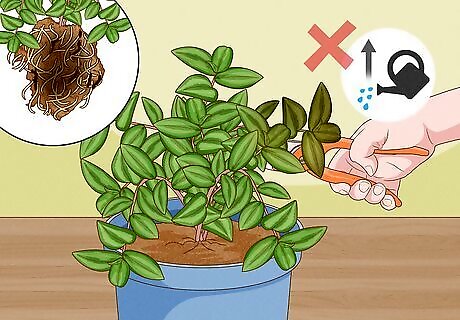
Stop root rot from spreading by cutting away any rotting vines. If the plant is fading in color, but the leaves are turning a faded yellow, the plant may be getting too much water, causing the roots to rot. If this is happening, the plant is probably not putting on much new growth, if any. Use sterilized scissors or shears to cut out the portion of the plant that is rotting. Make a cutting from a healthy part of the plant, toss out all the original soil, and replant the cutting. Root rot can spread very quickly, so act fast when you see signs of it. It can be heartbreaking to cut away a large chunk of your plant, but if you wait too long, you could lose the whole plant. Other signs of root rot include spongy, black roots.




















Comments
0 comment